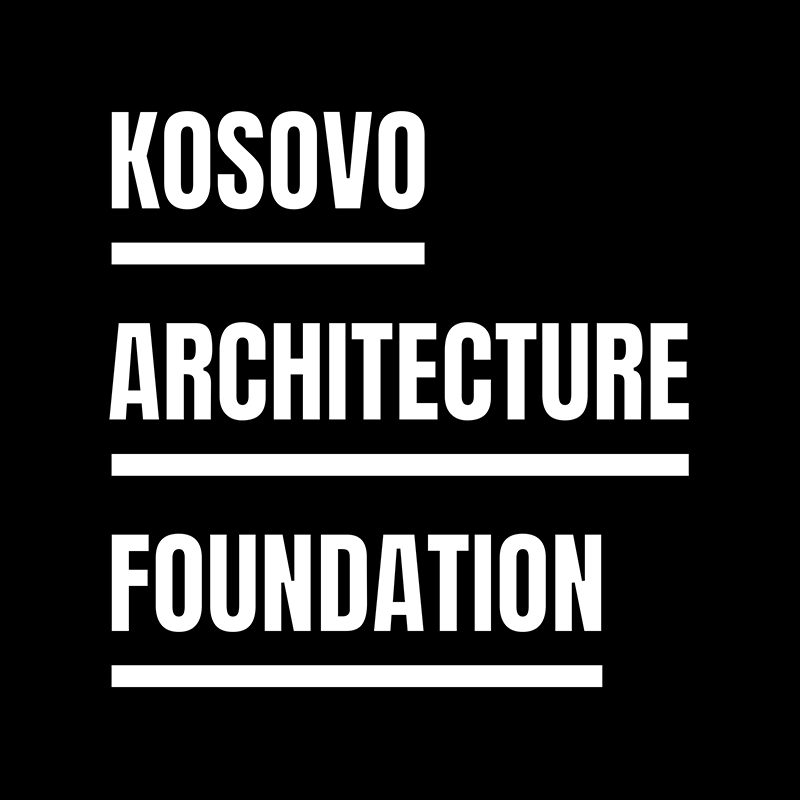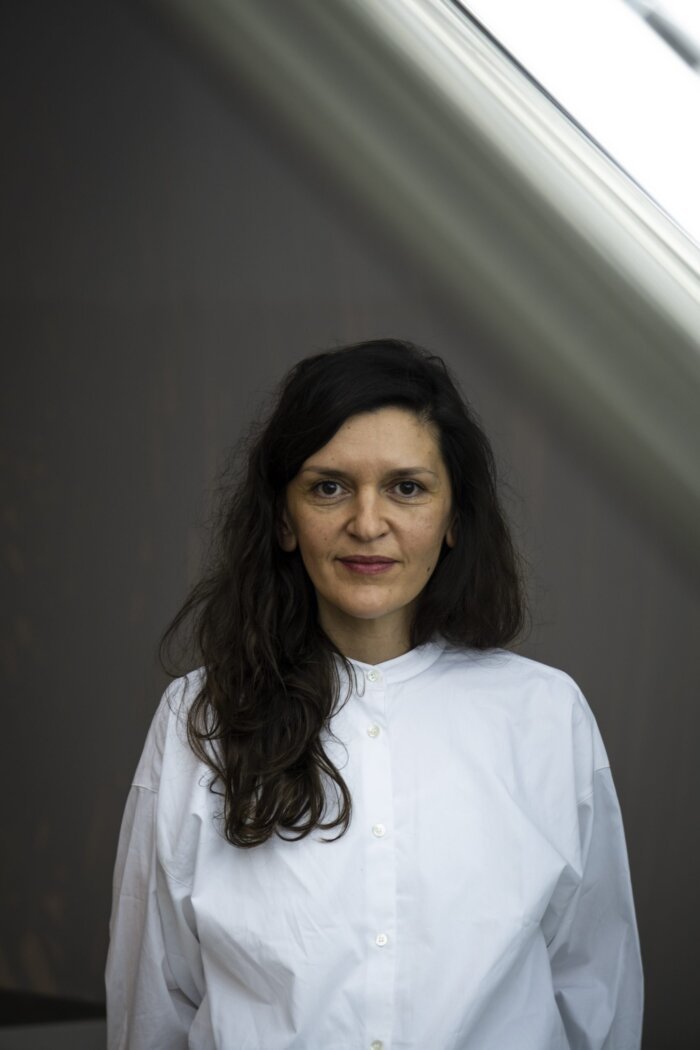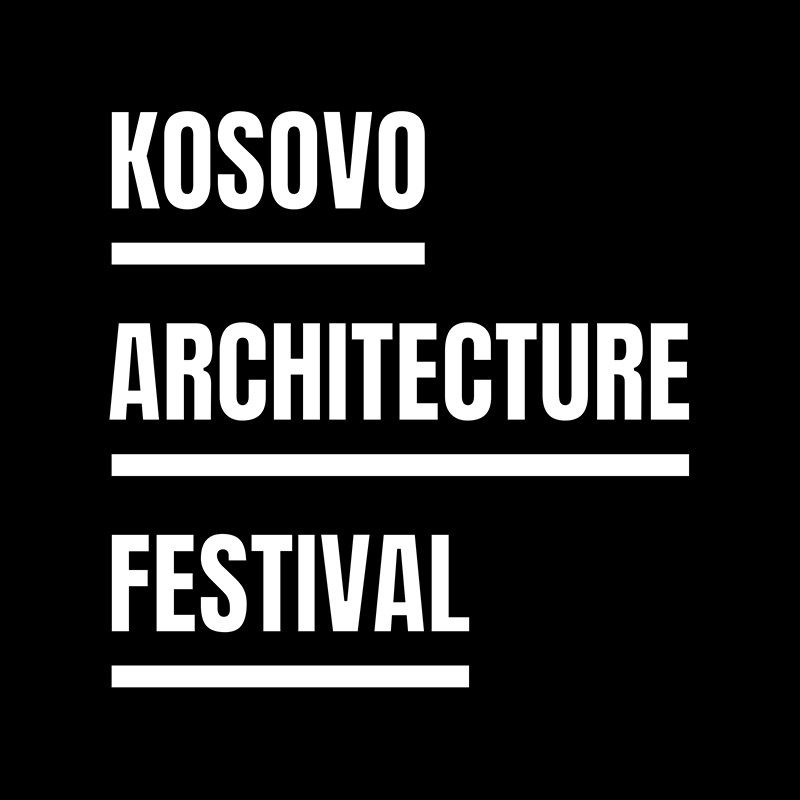
POLIKSEN QORRI-DRAGAJ & HAMDI QORRI

EN/
Poliksen Qorri-Dragaj & Hamdi Qorri
Time and Place: 8PM, 7th of July 2023, Kino Armata
Poliksen Qorri-Dragaj is an urban planner and research assistant at the Chair of Urban Planning at the RPTU Kaiserslautern-Landau, Germany. She studied architecture with specialization in urban planning at the Karlsruhe Institute of Technology. After graduating her studies in 2014, she worked as an urban planner at the planning office berchtoldkrass in Karlsruhe.
Her teaching focuses on urban design with an emphasis on urban climate adaptation, resilient urban development and mobility. As part of her PhD, she is researching the spatial effects of war and migration in Kosovar cities. Poliksen Qorri-Dragaj is currently participating in the research project “ReConstructionModules and Integrated Urban Development Ukraine” of RPTU Kaiserslautern-Landau, BTU Cottbus, TH Lübeck and TU Berlin, which is funded by the German Academic Exchange Service (DAAD). It offers teaching and exchange formats on topics related to the reconstruction of destroyed Ukrainian cities.
As an urban planner, her work ranges from classical framework planning and development concepts to mission statement development, interdisciplinary urban climate adaptation planning and overarching spatial analyses. Among others, Poliksen Qorri-Dragaj has led the following selected projects for berchtoldkrass:
Klimaanpassungskonzept / Climate Adaptation Concept, Freiburg im Breisgau: Due to its geographical location in the Upper Rhine Graben, the city of Freiburg i. Br. is one of the places with the highest average temperatures in Germany and is already feeling the effects of climate change on the well-being and health of its inhabitants. In order to actively and proactively counteract the future significantly increasing pressures, the climate adaptation concept was developed. The project was awarded in the “Climate Adaptation” category at the “Climate-Active Municipalities 2019” competition organized by the Federal Ministry for the Environment and the German Institute of Urban Affairs. It is nominated for the German Urban Development Prize 2023 in the category “Special Prize – Shaping Climate Change”, announced by the German Academy for Urban Development and Regional Planning (DASL)
Entwicklungsperspektive / Spatial development perspective Winterthur 2040: In recent years, the City of Winterthur has focused on carrying out long-term planning for areas with high pressure to act. The urban planning model shows how the city of Winterthur can develop sustainably by 2040. Future challenges for the city will be identified and the corresponding scope for development explored.
Mission Statement Baiersbronn Unterdorf: The project is accompanied by a broad public participation. The basic framework of the concept consists of three components: a “guideline” with the principles for the development, a “plan” for the concretization of the measures and a “script” for the presentation of the process. In the various projects Poliksen Qorri-Dragaj develops visualization strategies to represent urban planning concepts in digital and analog form.
About the Lecture
RKS² | TRANSCENDENT LOCALITY
Up to the present day, migration plays a significant role in the social development of Kosovo. It manifests itself in different forms, which differ in motives, manner and duration. The exhibition deals with a special form of migration, which illustrates that the migratory process is not completed with the simple move to another country. It often takes place in different phases, some of which end in a return to the home country. This return can be temporary, seasonal or permanent, but what they all have in common is that they ensure that connections and networks of different kinds are created between the homeland and the hostland. This form of migration can be described with the concept of translocality, a model of life that is becoming more and more prevalent – people living in multiple places at the same time, maintaining connections between hostland and homeland through communication, transfer of knowledge, information, material and immaterial goods.
In the course of the tense political situation and an ever-worsening marginalization of the Albanian population during the breakdown of the Yugoslavian Republic, hundreds of thousands of people sought refuge and protection abroad. In some cases, this flight would often last for decades without return.
During this conflict- and war-related migration wave in the late 1980s to the late 1990s, people fleeing found temporary arrival mostly in OECD countries, regulated in the form of a residence permit as politically persecuted persons. This legal status did not provide for a return to the homeland as long as the reason for flight had not been resolved and lifted. For many refugees, this represented a state of waiting and lingering, because the reason for migration was not a self-determined one – on the contrary, it was violently imposed from the outside.
The perceived locality of this migration group is the starting point for a spatial-philosophical narrative: transcendent locality. The concept of transcendence is variously described and defined from ancient to contemporary philosophy. Common to all meanings is that transcendence implies the process of crossing a boundary that separates two fundamentally different spheres.
For the individuals living in migration, the circumstance of not being able to return to their homeland for an indefinite period represented a deep caesura in their lives. On the one hand, the migrated individuals were physically present in the hostlands. superficially managing their everyday life and functioning in their new environment. But on the other hand, the emotional presence was a different matter: due to the conflict, attention and thoughts revolved around the abandoned homeland, fears and insecurities often did not allow the individuals to arrive in the hostland. They were located in an intermediate state between the physical present and the abandoned before. In this state, boundaries between the immanent being in the present and the transcendent being in the mind blur – the migrated individual is in a transcendent locality.
This project explores the impact of transcendent locality on immanent space in the short and long term: how the return of migrants after the war has affected Kosovar cities and how the social migration networks, which developed in the hostlands, impact on urban space in the form of translocal urbanism. It opens discussions on how urban planning can respond to these specific conditions in order to create urban resilience and liveable cities.
//
The installation serves as a metaphor for the idea of transcendence – the physical representation of a subjective state. It consists of an outer and an inner frame made of aluminium, in the middle of which a further frame made of neon tubes is located. All of these are multiplied horizontally.
Fragments
The installation is modularly assembled from individual parts. In the context of the project, this is how the transcendent locality is also composed. Individual fragments of memories and stories from the homeland are complemented by new impressions and experiences in the hostland and embed the transcendent locality in it. Memories and new impressions mean that this place is subject to a constant dynamic and never reaches a final state.
In between
Through migration, the center of life is left behind and, with increasing time, is supplemented by a second home in the hostland – this can be seen as a gain. Translocality, however, also strengthens the state of being in between.
The exterior and interior frames pick up on this motif as fixed constructions, in which the feeling of being in between is picked up by the neon.
Multiplication
The subjective confrontation and reflection with one’s own transcendent and immanent location in the context of migration is repeated again and again and becomes a constant companion.
The installation as a physical construct and as a metaphor depends very much on the individual perspective. Viewed from a distance, fragments, layers and spaces in between result in a coherent picture and, conversely, dissolve into their individual parts with increasing proximity – similar to the transcendent locality, which transforms into translocality and no longer lets people leave the intermediate state of proximity and distance between two places of being at home.

AL/
Poliksen Qorri-Dragaj & Hamdi Qorri
Koha dhe Vendi: 8 Korrik 2023, nga ora 20:00 ne Kino Armata
Poliksen Qorri Dragaj është urbaniste dhe asistente kërkimore në Katedrën e Planifikimit Urban në RPTU Kaiserslautern-Landau, Gjermani. Ajo ka studiuar arkitekturë me specializim në planifikim urban në Institutin e Teknologjisë në Karlsruhe. Pas diplomimit të studimeve në vitin 2014, ajo punoi si planifikuese urbane në zyrën e planifikimit berchtoldkrass në Karlsruhe.
Mësimdhënia e saj fokusohet në dizajnin urban me një theks në përshtatjen e klimës urbane, zhvillimin urban resilient dhe mobilitetit. Si pjesë e doktoratës së saj, ajo është duke hulumtuar efektet hapësinore të luftës dhe migrimit në qytetet kosovare. Poliksen Qorri-Dragaj aktualisht po merr pjesë në projektin kërkimor “ReConstructionModules and Integrated Urban Development Ukraine” të RPTU Kaiserslautern-Landau, BTU Cottbus, TH Lübeck dhe TU Berlin, i cili financohet nga Shërbimi Gjerman i Shkëmbimeve Akademike (DAAD). Ai ofron formate mësimore dhe shkëmbimi për tema që lidhen me rindërtimin e qyteteve të shkatërruara të Ukrainës.
Si një planifikuese urbane, puna e saj varion nga konceptet e planifikimit dhe zhvillimit klasik deri te zhvillimi i koncepteve urbane, planifikimi ndërdisiplinor i përshtatjes së klimës urbane dhe analizat gjithëpërfshirëse hapësinore. Ndër të tjera, Poliksen Qorri-Dragaj ka udhëhequr projektet e mëposhtme të përzgjedhura për berchtoldkrass:
Klimaanpassungskonzept / Koncepti i Përshtatjes Klimatike, Freiburg im Breisgau: Për shkak të vendndodhjes së tij gjeografike në Rhine Graben të Epërm, qyteti i Freiburg i. Br. është një nga vendet me temperaturat mesatare më të larta në Gjermani dhe tashmë po ndjen efektet e ndryshimeve klimatike në mirëqenien dhe shëndetin e banorëve të saj. Për të kundërshtuar në mënyrë aktive dhe proaktive presionet në rritje të konsiderueshme në të ardhmen, u zhvillua koncepti i përshtatjes klimatike. Projekti u vlerësua në kategorinë “Përshtatja klimatike” në konkursin “Bashkitë Aktive në Klimë 2019” organizuar nga Ministria Federale për Mjedisin dhe Instituti Gjerman i Çështjeve Urbane. Është nominuar për Çmimin Gjerman për Zhvillimin Urban 2023 në kategorinë “Çmimi Special – Formësimi i Ndryshimeve Klimatike”, shpallur nga Akademia Gjermane për Zhvillim Urban dhe Planifikim Rajonal (DASL)
Entwicklungsperspektive / Perspektiva e zhvillimit hapësinor Winterthur 2040: Në vitet e fundit, qyteti i Winterthur-it është fokusuar në kryerjen e planifikimit afatgjatë për zonat me presion të lartë për të vepruar. Modeli i planifikimit urban tregon se si qyteti i Winterthur-it mund të zhvillohet në mënyrë të qëndrueshme deri në vitin 2040. Sfidat e ardhshme për qytetin do të identifikohen dhe do të eksplorohet hapësira përkatëse për zhvillim.
Deklarata e Misionit Baiersbronn Unterdorf: Projekti shoqërohet nga një pjesëmarrje e gjerë publike. Kuadri bazë i konceptit përbëhet nga tre komponentë: një “udhëzues” me parimet e zhvillimit, një “plan” për konkretizimin e masave dhe një “skrip” për paraqitjen e procesit. Në projektet e ndryshme Poliksen Qorri-Dragaj zhvillon strategji vizualizimi për të përfaqësuar konceptet e planifikimit urban në formë dixhitale dhe analoge.
Rreth Ligjerates
Deri më sot, migrimi ka pasur rol të rëndësishëm në zhvillimin social të Kosovës. Manifestohet në forma të ndryshme, të cilat dallojnë për kah motivet, mënyra dhe kohëzgjatja. Ekspozita trajton një formë të veçantë të migrimit, e cila ilustron se procesi i migrimit nuk përfundon me shpërnguljen e thjeshtë në një vend tjetër. Shpesh zhvillohet në faza të ndryshme, disa prej të cilave përfundojnë me kthimin në vendlindje. Ky kthim mund të jetë i përkohshëm, sezonal ose i përhershëm, por e përbashkëta e tyre është se ato bëjnë të mundur krijimin e lidhjeve dhe rrjeteve të llojeve të ndryshme midis vendlindjes dhe vendit emigrues. Kjo formë migrimi mund të përshkruhet me konceptin e translokalitetit, një model jete që po bëhet gjithnjë e më i përhapur – njerëzit që jetojnë në shumë vende në të njëjtën kohë, duke ruajtur lidhjet midis vendlindjes dhe vendit emigrues përmes komunikimit, transferimit të njohurive, informacionit, të mirave materiale dhe jomateriale.
Në rrjedhën e situatës së tensionuar politike dhe një margjinalizimi të përkeqësuar të popullsisë shqiptare gjatë shpërbërjes së Republikës Jugosllave, qindra mijëra njerëz kërkuan strehim dhe mbrojtje jashtë vendit. Në disa raste, kjo ikje shpesh do të zgjaste për dekada pa kthim.
Gjatë kësaj vale të migrimit për shkak të konfliktit dhe luftës në fund të viteve ‘80 deri në fund të viteve ‘90, njerëzit që iknin gjetën strehim të përkoshëm kryesisht në vendet e OBZE-së, të rregulluar në formën e një leje qëndrimi si persona të përndjekur politikë. Ky status ligjor nuk parashihte kthim në vendlindje për sa kohë nuk i ishte dhënë zgjdihje dhe fund arsyes së ikjes. Për shumë refugjatë, kjo përfaqësonte një gjendje pritjeje dhe ngecjeje, sepse arsyeja e migrimit nuk ishte nga vetëdëshira– përkundrazi, ajo ishte e imponuar me dhunë nga jashtë.
Lokaliteti i perceptuar i këtij grupi migrues është pikënisja për një narrativë hapësinore-filozofike: lokalitet transcendent. Koncepti i transcendencës përshkruhet dhe përkufizohet në mënyra të ndryshme që nga filozofia e lashtë e deri në atë bashkëkohore. E përbashkët për të gjitha kuptimet është se transcendenca nënkupton procesin e kapërcimit të një kufiri që ndan dy sfera thelbësisht të ndryshme.
Për individët që jetonin në migrim, rrethana e moskthimit në vendlindje për një periudhë të pacaktuar përfaqësonte një cezurë të thellë në jetën e tyre. Nga njëra anë, individët e që migronin ishin fizikisht të pranishëm në vendet emigruese, duke menaxhuar në mënyrë sipërfaqësore jetën e tyre të përditshme dhe funksionimin në mjedisin e tyre të ri. Por nga ana tjetër, prania emocionale ishte një çështje tjetër: për shkak të konfliktit, vëmendjes dhe mendimeve që silleshin rreth vendlindjes së braktisur, frika dhe pasiguritë shpesh nuk i lejonin individët të arrinin në vendet e huaja. Ata ndodheshin në një gjendje të ndërmjetme midis të tashmes fizike dhe asaj të braktisur më parë. Në këtë gjendje, kufijtë midis qenies imanente në të tashmen dhe qenies transcendente në mendje mjegullohen – individi migrues e gjenë veten në një lokalitet transcendent.
Ky projekt hulumton ndikimin e lokalitetit transcendent në hapësirën imanente në periudhën afatshkurtër dhe afatgjatë: si ka ndikuar kthimi i migrantëve pas luftës në qytetet kosovare dhe si rrjetet sociale të migrimit, të cilat u zhvilluan në vendet emigruese, ndikojnë në hapësirën urbane në formën e urbanizmit translokal. Ai hap diskutime se si planifikimi urban mund t’i përgjigjet këtyre kushteve specifike në mënyrë që të krijojë qëndrueshmëri urbane dhe qytete të jetueshme.

Instalacioni shërben si një metaforë për idenë transcendente – paraqitjen fizike të një gjendjeje subjektive. Ai përbëhet nga një kornizë e jashtme dhe e brendshme prej alumini, në mes të së cilës ndodhet një kornizë e mëtejshme e bërë nga tuba neoni. Të gjitha këto shumëzohen horizontalisht.
Fragmente
Instalacioni është montuar në mënyrë modulare nga pjesë të veçanta. Në kuadër të projektit, kështu është i përbërë edhe lokaliteti transcendent. Fragmente të veçanta kujtimesh dhe tregimesh nga vendlindja plotësohen me përshtypje dhe përjetime të reja në vendet emigruese dhe ngulitin lokalitetin transcendent në të. Kujtimet dhe përshtypjet e reja nënkuptojnë se ky vend i nënshtrohet një dinamike të vazhdueshme dhe nuk arrin kurrë një gjendje përfundimtare.
Në mes
Nëpërmjet migrimit, pjesa qëndrore e jetës lihet pas dhe, me kalimin e kohës, ajo plotësohet nga një shtëpi e dytë në vendin emigrues – kjo mund të shihet si gjë e dobishme. Translokaliteti, megjithatë, forcon njëtrajtshëm gjendjen e të qenit në mes.
Kornizat e jashtme dhe të brendshme i trajtojnë këto motive si konstruksione të fiksuara, në të cilat ndjesia e të qenit në mes vërehet nga neoni.
Shumëzimi
Përballja dhe reflektimi subjektiv me vendndodhjen e vet transcendente dhe imanente në kontekstin e migrimit përsëritet dhe bëhet një bashkëudhëtar i vazhdueshëm.
Instalacioni si konstrukt fizik dhe si metaforë varet shumë nga këndvështrimi individual. Shikuar nga larg, fragmentet, shtresat dhe hapësirat në mes rezultojnë në një pamje koherente dhe, në mënyrë të kundërt, shkrihen në pjesët e tyre individuale duke rritur afërsinë – e ngjashme me lokalitetin transcendent, i cili shndërrohet në translokalitet dhe nuk i lë më njerëzit të largohen nga gjendja e ndërmjetme e afërsisë dhe distancës midis dy vendeve të të qenit në shtëpi.


